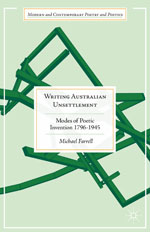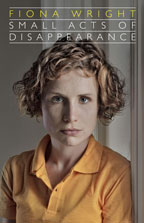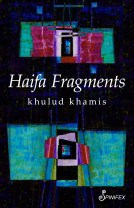Ashley Haywood reviews “Nothing Sacred” by Linda Weste
by Linda Weste
Australian Scholarly Publishing
ISBN 978-1-925333-22-0
Reviewed by ASHLEY HAYWOOD
Nothing Sacred, a novel in free verse, spans an historical denouement: the decades precipitating the climatic assassination of Julius Caesar in 44 BCE, and the eventual fall of the late Roman Republic. After Caesar’s death, a second triumvirate was formed which would be the last oligarchy before the Roman Empire was established under Octavian Augustus. After history lessons and Shakespeare and HBO, it can be difficult to image that the major dramatis personae of this time were actually living and breathing this end of an era. What would it have been like? Is it possible to imagine Caesar, Mark Antony, Cicero and Catullus, to name a few familiar names—and all of whom are ‘players’ in Nothing Sacred—free of set design and stage effects, character direction and costume, as like you or me dealing or not dealing with the signs of political and social unrest?
Linda Weste introduces lesser-known historical figures alongside major figures of the late Republic in Nothing Sacred, her first novel. This narrative manoeuvre helps to disrupt theatrical expectations of this historical period. Weste’s climax is not the assassination of Caesar. She sidesteps stage doors and curtain calls, and takes the reader into the ‘dung-smeared’ streets of Rome. We know the streets before we’re seated in scenes with the Senate, listening to Cicero’s orations; before we’re among spectators at the Circus Maximus, where we witness the slaughter of exotic animals for entertainment, including a family of elephants, ‘tucking the calves / between their legs’, a ‘Collective armour: / This behaviour, from beasts?’ (‘Gargantuan’). When the blood-lust crowd doesn’t cheer this time, but hurls abuse at Pompey their General, we have some understanding of their empathy. After all, we’ve seen Crassus at work, for example, refusing to douse yet another fire ‘raging through the insulae, / the rootless apartment blocks’ unless he stands to make a profit. (Caesar, Pompey and Crassus formed the First Triumvirate alliance.)
Weste shows us the streets of her Rome through siblings Clodia Metelli (assumed here to be the Lesbia of Catullus’ poems) and Clodius Pulcher of the politically elite family Claudii Pulchri. On the way to their mother’s funeral, we meet them: ‘Father’s hired mourners to wail: won’t allow / his children to beat themselves with grief // But when the stranger drops to her knees, / and ululates in hoots and howls …’ (‘Awakening’), it is as if the siblings memories were distributed along with the coins; ‘When she tugs her hair / and complicated webs tangle her hands; / When she pounds her forehead on the stones …’ (‘Awakening’), a sense of diffusion and entanglement is felt, which extends throughout the narrative, interconnecting multiple narrators, the city and its inhabitants. Clodia narrates the suite of Prelude poems, establishing this sense of connectedness with city motifs: ‘labyrinthine streets’, ‘sprawling crossroad[s]’, ‘huddles of shapes’, and of dead things, ‘Sooner or later, hooves or wheels compel it all / into the drains’, and even her mother’s tomb is ‘Where everything and nothing / is.’
Clodia and Clodius are nodal to Weste’s telling, but they are two among several homodiegetic narrators, and two among, at least, nineteen named characters (the reader will be grateful for Weste’s Dramatis Personae). As the reader becomes familiar with Weste’s language patterns—similar but different for each narrator like Rome’s streets—they begin to read like the intercommunicating parts of a singular organism. With this in mind, Nothing Sacred is receptive to the collective distress of a city, or receptive to fissures, anticipating the ‘psychological gulf that opens at the end of an era’. Ted Hughes wrote this thinking of Ovid’s Metamorphoses (published in 8 AD during the time of Augustus, and around the same time Christ was born) in an introduction to his Tales from Ovid (1997). These fissures are corpulent in Nothing Sacred. They form and fan out from the body-politic head of Rome, Palatine hill where Rome’s elite reside. At times, these fissures as subtle as hangnail, as in ‘Hard to Swallow’:
On the near side of his thumb, what’s that? A flap of skin
flags his unhinging; the epitome of everything
he must gnaw at in frustration.
Other times, these fissures infiltrate the munera, spectacles at the Circus Maximus. As mentioned above, the death of twenty-some elephants shock the crowd into empathy (‘Gargantuan’). And the hippopotamus, through Clodia, mimics the crowd:
The beast’s deep-throated reverb-
eration, a slow, course chuckle,
heh heh heh he-gh
like traders sharing dirty jokes in the marketplace
heh heh heh he-gh
If being at the Circus Maxima is ‘all about nisi videre et videri / seeing, and being seen’, what are we are really seeing when: A thin grey eel curls upward out of its mouth / and suddenly I can’t hear for squeals! (‘The Beast Within’).
Weste moves in the spaciousness of the page-as-canvas, often freeing her verse (and her characters) from the tyranny of the left margin in waves of stepped lineation and spacing toward the right margin, and back again to the left or centre fold. These movements across the page give a kind of topography to characters’ ruminations and gestures. Take ‘The Circus Maximus’, for example:
Cicero stiffer than a plank:
‘We …
… are not
facin-a-ted
with death,
it’s near-ness or avoid-ance.
We are fascin-a-ted
![]()
![]() By vic-tor-y,
By vic-tor-y,
![]() Cae-lius.
Cae-lius.
![]()
![]() Vic-tor-y.’
Vic-tor-y.’
There’s a grisly
![]()
![]() cruck
cruck
![]()
![]()
![]()
![]() cruck
cruck
![]()
![]()
![]()
![]()
![]()
![]() cruck
cruck
![]()
![]()
![]()
![]() as Cicero cricks his neck
as Cicero cricks his neck
![]()
![]() That’ll be … my turn … over.
That’ll be … my turn … over.
‘Auronius told me the other day
Twenty-nine gladiators from German-ia
![]()
![]()
![]() str-angled
str-angled
![]()
![]()
![]() each other
each other
to avoid the ring …’
(‘The Circus Maximus’)
The rhythm of Weste’s verse relies on styles of poetic repetition, especially: alliteration, anaphora (word repetition), assonance (vowel repetition), and homoioteleuton (repetition of the endings of words)—styles associated with Catullus’ poetry, as well as the contemporary poetry of late Republic. Styles of poetic repetition, or figures of speech, serve to heighten emotional intensity before serving rhyme. With free verse, if rhyme predominates, poetic urgency can risk loosing its grip. Sometimes this is felt in Weste’s verse. But it can also be a tool, for example, when Clodius’ ‘grip’ is challenged: ‘The heated floor, the wisps of steam / That musky mildew smell; / But no conspirators as far as I can tell’ (‘Right Hand Man’).
Often Weste allows her poems to slip in their meanings when end lines are left without full-stops, or with ellipses, or with a verb in its present participle form; such as, when ‘The beast surges through // Sideswiping red mud’, the crocodile gets to keep the human leg she’s won (‘Crocodilius’). Or when we hear Clodius’ last wishes for his enemy Milo: ‘To bob along like bloated meat // a nobody nudging the bank (‘Malediction’). The next poem ‘Obsession’ opens: ‘By the time we reach the shrine’.
Nothing Sacred is a network of character narratives, which can challenge readers’ orientation, though Weste deploys a number of literary techniques to help the reader distinguish who is speaking, who is listening; most often, characters are named in dialogue. We also come to recognise characters’ speech patters, such as Cicero’s drawl, and Catullus’ Capote-like nips and desires, especially in the ‘Working the Room’ poems (I’m not the first reviewer to see Truman Capote in Weste’s Catullus). If I felt disorientated, it also felt like a necessary confusion, and this was what led to my thinking about characters’ narratives as parts of an intercommunicating body, a writhing city and its inhabitants, sensing its fissures.
The tone of Nothing Sacred is like an extended denouement, a prolonged pre-climax, made more playful with, but not necessarily sustained by, Weste’s interest in sexual metaphor, or Latin ‘vulgarisms’, most of which are listed in an interesting and useful Notes section. Character tones range from playful to conspiratorial, deliberation to preparation, vigilant to radical. But the overall tone, or sensation, of coming-to seems to be sustained by Clodia, who is all of these actions, feeding the narrative’s (or body’s) momentum more than any other character; in a way, the narrative is Clodia’s body, whose voice opens and closes Nothing Sacred.
Weste’s verse novel adds to the still increasing number of published verse novels by Australian poets. Recent others include, The Petrov Poems (2013) by Lesley Lebkowicz and Jake (2008) by Judy Johnson on the Torres Strait pearl shell industry in the 1930s. The verse novel resurgence in Australia was largely led by the success (far-reaching readership) of Dorothy Porter’s verse novel The Monkey’s Mask (1994). The contemporary verse novel is an attractive entry into poetry for new readers—for its readability—which Nothing Sacred delivers, and more for the reader of poetry. Overseas, verse novels make best-seller lists; for example, Omeros (1990) by Caribbean poet Derek Walcott, and, more recently, the experimental verse novels The Autobiography of Red (1998) and Red Doc> (2013) by Canadian poet Anne Carson. Nothing Sacred is for an international audience (as much as an Australian one) for its historical material and contemporary verse. Somewhat comparable to Weste’s historical material is Peter Rose’s The Catullan Rag (1993), so far as both poets similarly understand Catullus from his poems (and extensive literary research on the poet). The potential of the verse novel reaches as far back as its ancient origins (Gilgamesh, Homer’s Illiad and Odyssey, epics during Augustus’ Rome by Virgil and Ovid) and as far forward as contemporary verse. Weste makes use of both arms’ length, manipulating historical material in its time and place to be re-seen, effectively giving us a new experience of the late Roman Republic.

 Hook and Eye
Hook and Eye Writing Australian Unsettlement: Modes of Poetic Invention 1796-1945
Writing Australian Unsettlement: Modes of Poetic Invention 1796-1945





